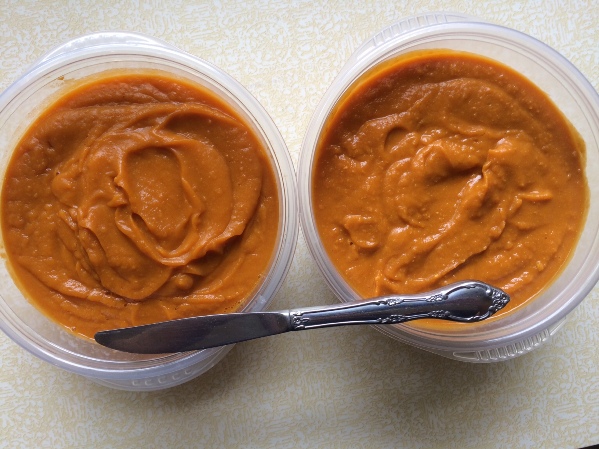Today marks the ten-year anniversary of Transformation, so in celebration of this special day I would like to share a few more shortcuts that simplify eating healthy. If you want to make the nutritarian eating-style a long term, sustainable part of your life--one that doesn't over consume your focus or time, simplification is important in order to achieve that goal.
(If you are new to my blog, here are the first two posts on the topic: Making Healthy Food Convenient . . . and . . . Making Healthy Food Convenient; part 2.)
Tip #1: batch cook
I double, triple, quadruple a recipe or ingredient in order to freeze into smaller portions to use later.
For instance, if I’m making quinoa, I cook the entire contents of the bag and then freeze portions to add to soups, entrees, and salads later on.
Cooked quinoa ready for the freezer. (The knife is to show the size of the containers. This one is a 6-cup container.)
If I’m cooking butternut squash in the microwave, I cook a very large one in order to make a double portion of puree to add to soups later on.
Butternut squash puree adds so much flavor to soup or poured over steamed veggies. Simply put a cooked squash (seeds included) into a high-speed blender and add 4 cups of organic carrot juice. Blend until smooth. (Juice made from conventional carrots is bitter--only use organic carrot juice for flavoring. Organic carrot juice may be found in the produce section of most grocery stores.)
If I’m cooking beans, I cook an entire pot of beans at a time to divide and freeze. (I use an Instapot for speed.)
Tip #2: make high-nutrient soups in baby steps
In the winter months, I enjoy spending an hour or two in the kitchen in order to cook a large pot of vegetable/bean soup. There’s nothing more satisfying than heating up a chilly kitchen with the fragrant aromas of cooked vegetables, beans, onions, garlic, and spices.
However, in the summer months, I’d rather be outdoors. Spending time in a kitchen over a hot stove is not high on my list. And to be honest, if I don’t have high-nutrient food on hand, it’s easy to grab something not as nourishing.
In order to simplify the cooking process in the summer months, I keep a gallon-size ziplock bag in the freezer. When I have scraps of chopped celery hearts; or extra time to chop carrots, peppers, onions, and mushrooms—I add them to the bag. On soup-making day, I simply take them out of the freezer and add them to the pot.
Chopped celery hearts, carrots, peppers--sliced mushrooms were added after I took this picture.
When small bags of frozen vegetables such as peas, corn, chopped broccoli or kale go on sale for 10 bags/$10, I buy them to save for later. The same goes for cans of unsalted beans. I buy them on sale--and then have them on hand for convenience sake.
I freeze the butternut squash and carrot juice puree in 6-cup containers too. This is the perfect amount to flavor a pot of soup.
On hot summer days, I cook soup in a crock pot. I simply assemble: frozen squash/carrot juice puree, the ziplock bag of chopped veggies, and a 32 oz can of chopped tomatoes or a quart jar of canned tomatoes from last summer’s garden. I plug the crock pot into an electrical outlet that’s not in an air conditioned part of our home . . . our three-season room--my art studio. I then cook on high for 4 hours or on low for 8 hours.
Veggie/bean soup cooking in my un air conditioned studio on a hot day.
Half hour before serving, I add three different bags of frozen vegetables and my family's favorite spices. I like to include freshly chopped basil and garden greens too. When the frozen vegetables are thoroughly heated, it's time to eat! (I like to pour hot soup over quinoa.)
Fresh greens from the garden (and a few cherry tomatoes).
Each of these steps can be done in incremental steps as you have time days, or even weeks ahead. Simply assemble everything together when you are ready to cook.
Eating for health doesn’t need to be all consuming or complicated in order to reap the many disease-preventing benefits it provides.
Here's to making this way of eating an every day part of life!
It's not a "have to" but a "get to!"
Enjoy!
Emily Boller, artist, mother, and author of Starved to Obesity, lost 100 pounds more than fifteen years ago by eating an abundance of high-nutrient, plant-rich foods. Today, she’s certified in whole plant nutrition from the Nutritarian Education Institute. She’s on a mission to combine practical, no-nonsense and cost-effective tips—with easy to understand science—in order to help anyone escape the addictive grip of the Standard American Diet. And now, she’s on a mission to bring awareness to the suffocating and potentially deadly trap of eating disorders as well.






